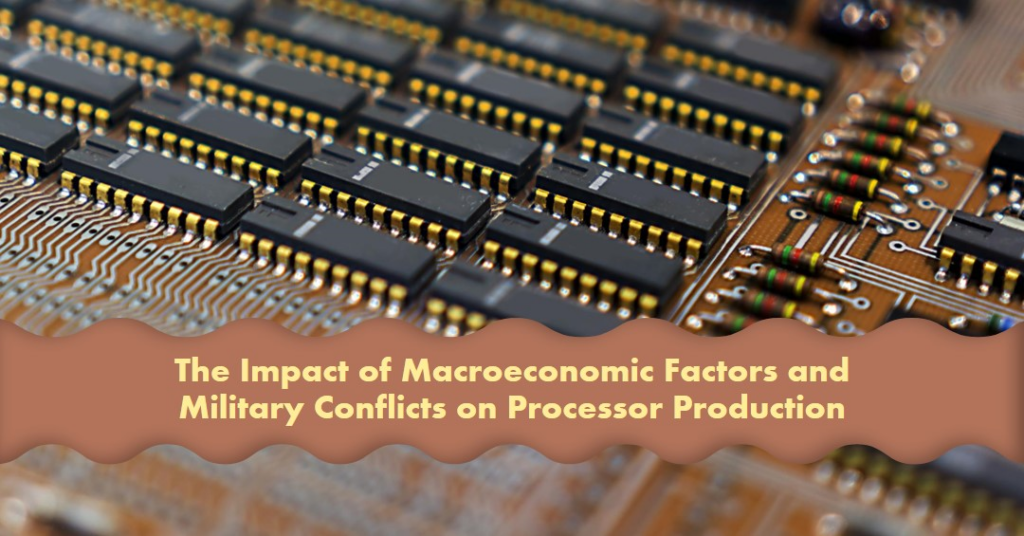Abstract:
This article explores the intricate relationship between macroeconomic elements and military conflicts on the global production of processors. In an era where technological advancement is pivotal, understanding the influence of economic policies, global market dynamics, and geopolitical tensions on this sector is crucial. The article aims to provide an in-depth analysis of how these factors collectively shape the processor manufacturing industry, a cornerstone of modern technology.

Contents:
- Introduction
- Macroeconomic Factors Influencing Processor Production
- The Effect of Military Conflicts on Processor Supply Chains
- Global Market Dynamics and Processor Production
- Government Policies and Processor Manufacturing
- Challenges and Resilience in the Processor Industry
- Future Outlook: Predictions and Trends
- Conclusion
- FAQs
1. Introduction
The production of processors, a critical component in virtually all modern technology, is significantly influenced by both macroeconomic factors and military conflicts. This article delves into how these aspects affect the supply chain, production rates, and overall industry health, offering insights into the complex interplay of economics and geopolitics in this field.
2. Macroeconomic Factors Influencing Processor Production
The processor production industry is highly sensitive to global macroeconomic trends. Factors such as international trade policies, economic growth rates, and currency fluctuations play a significant role in shaping the industry.
List of Key Macroeconomic Factors:
- International Trade Policies and Tariffs
- Economic Growth and Stability of Key Markets
- Currency Exchange Rate Fluctuations
- Interest Rates Impacting R&D Investment
3. The Effect of Military Conflicts on Processor Supply Chains
Military conflicts can have a profound impact on the processor industry, primarily through disruptions in supply chains and the availability of critical raw materials.
Disruption of Supply Chains: Military conflicts in or near critical regions can disrupt the supply of raw materials and components needed for processor manufacturing. This disruption can lead to delays in production and increased costs.
Impact on Raw Material Availability: Many processors rely on rare earth elements and other materials that are sourced from conflict-prone areas. Military conflicts can restrict access to these materials, posing significant challenges to manufacturers.
Logistical Challenges: Conflicts can also lead to logistical challenges, including increased transportation costs and difficulties in shipping products to and from manufacturing sites. This can affect the timely delivery of finished processors to the market.
Shifts in Global Production: In response to these challenges, companies may need to shift production to more stable regions, which can be a costly and time-consuming process.
List of Military Conflict Impacts:
- Disruption of Global Supply Chains
- Restricted Access to Essential Raw Materials
- Increased Logistical and Transportation Challenges
- Necessity for Shifting Production to Stable Regions
4. Global Market Dynamics and Processor Production
The global demand for processors, driven by the tech industry’s expansion and consumer electronics’ proliferation, is a key factor in production dynamics. This segment analyzes how market demand influences manufacturing decisions, pricing strategies, and investment in new technologies.
5. Government Policies and Processor Manufacturing
Government interventions play a critical role in shaping the processor manufacturing landscape. Various policies, from subsidies to technological investments, significantly impact the industry.
Subsidies and Incentives: Governments can offer subsidies and tax incentives to processor manufacturers, encouraging domestic production and research and development activities.
Regulatory Environment: Regulations concerning technology exports, environmental standards, and labor laws can impact production costs and operational efficiencies.
Investment in Technology: Public investment in technological research can lead to breakthroughs in processor technology, influencing the industry’s trajectory.
Trade Agreements: Bilateral and multilateral trade agreements can open new markets or impose barriers, altering the competitive landscape for processor manufacturers.
6. Challenges and Resilience in the Processor Industry
The processor industry faces a myriad of challenges, yet it demonstrates remarkable resilience and adaptability.
Technological Complexity: Advancements in processor technology require substantial R&D investments and sophisticated manufacturing processes.
Competition and Market Saturation: Intense competition from established and emerging players can lead to market saturation, pressuring companies to innovate continually.
Supply Chain Vulnerabilities: The industry is susceptible to supply chain disruptions due to its reliance on global networks for raw materials and components.
Adapting to Market Demands: Rapid changes in technology and consumer preferences require agile production and marketing strategies.
Despite these challenges, the industry has shown resilience through innovation, diversification of supply chains, and strategic global partnerships.
7. Future Outlook: Predictions and Trends
The future of processor production is likely to be shaped by several key trends and predictions.
Integration of AI and Machine Learning: Increasing integration of AI and machine learning in manufacturing processes could lead to more efficient and intelligent processor designs.
Focus on Sustainability: Growing environmental concerns may drive the industry towards more sustainable manufacturing practices and eco-friendly materials.
Geopolitical Shifts: Changes in global geopolitics could lead to the reorganization of supply chains and production strategies.
Emerging Markets: The rise of emerging markets could see a shift in consumer demographics, influencing product development and marketing strategies.
The processor industry is set to continue its path of rapid innovation and adaptation, responding to both the challenges and opportunities presented by the global economic and geopolitical landscape.
8. Conclusion
The article concludes by summarizing the critical influences of macroeconomic factors and military conflicts on processor production and their implications for the future of technology and global economics.
9. FAQs
Q1: How do economic recessions impact processor manufacturing?
Q2: What role do military conflicts play in global processor supply chains?
Q3: How do government policies affect processor production in different countries?
Q4: What are the major challenges faced by the processor industry today?
Q5: What future trends are expected to shape processor production?
Leave a Reply